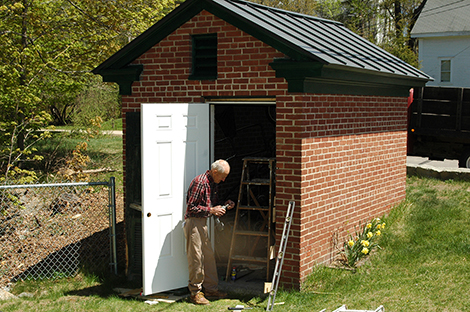
Bryant Adams has been repairing the old pumping station on Maple Street, which had fallen into disrepair over the years. According to Bryant, the small brick building hadn’t had any significant work done on it since it was built in 1942 or ’43. Mead and Braley installed a standing seam roof, but the rest – fascia boards, custom trim, new returns, and a new door – has been all of Bryant’s work.
Although the building is now just used for storage, it once housed an important piece of railroad equipment – an electric pump to recharge the water tank at the East Andover railroad station. The water was vital for filling the steam locomotives that ran along the old Northern Railroad line.
For years before the pumping station was built, Bryant managed the filling of the water tank using a flume, a water wheel, and a hydraulic ram in the old Busiel Hosiery Mill, just below the Highland Lake dam.
But during World War II, freight traffic through Andover increased greatly, with some trains pulled by three locomotives. Trying to meet the greatly increased demand for water, the hydraulic ram system began pulling more water than Highland Lake could reasonably supply, so the railroad built the pumping station on Maple Street and fitted it with an efficient electric pump.
At least that’s the way Bryant remembers it. Ralph Chaffee, writing in the April 26, 1962 Franklin Journal-Transcript, gives a slightly different (and more colorful) version of the origin of the pumping station and the switch to electric:
Originally, the water tower at East Andover, he writes, “was filled by a hydraulic ram operated by a water wheel in the basement of the Busiel Hosiery Mill. The railroad paid $10 per month for this service, at least in the 1930s. The town became obliged to take over this property for taxes, and when repairs became necessary to the flume carrying water to the wheel, the selectmen suggested that the railroad pay an additional $2.50 per month, or $25 a year to help defray the cost. The Division Superintendent Arthur Perkins refused, on the grounds that the railroad couldn’t afford it, and that anyhow the water tower at Halcyon wasn’t needed, as there was another at Franklin and one at Potter Place.
“The selectmen then served notice that after a certain date the town was all done supplying the tower, and the Boston and Maine could do whatever it saw fit. Then it suddenly developed, too late, that that tower was very necessary indeed, since a long northbound freight could not stop for water at either Franklin or Potter Place and get started again on the long grades. Negotiations began in earnest, ending in the erection by the railroad of a brisk pumping station at the outlet of Highland Lake with a new large pipe line, deeply buried below frost, extending to the tower, all at an outlay of perhaps $7,000 or $8,000 to save the payment of a paltry $25 a year.
“And when the new automatic pump was put in operation it refused to ‘automat’ properly, and the electric bill for the first month was over $60. While all this was going on the Boston and Maine was already in the process of changing to diesel power, and the new system was in use only a short time before being unneeded and abandoned. The town purchased the new pumping station for one dollar.
“Eliminating the old water wheel pump was a boon on the town, as it probably drained one hundred gallons of water from Highland Lake to put one gallon in the water tower. The advantage of helping to maintain a constant summer lake level far outweighed the loss of a few dollars extra revenue.
“After a few such experiences with railroad management one is less inclined to wonder at the railroad’s present financial distress.”